Thera Wall Paintings Copies P. Nomikos Museum
The life-sized three-dimensional wall-paintings reproduced and exhibited here were sponsored by the "Thera Foundation, Petros M. Nomikos", and produced in France by Transfer Relief SA, using the Kodak Pathé process. Other similar Kodak Pathé commissions have been funded by the Getty Museum of California and the French government for the Egyptian tomb of Sennefer and the Lascaux Caves, respectively.
The manufacturing of these images involved a long, complex, and laborious process which necessitated the transfer of photographic emulsions onto a synthetic substrate that exactly replicates that of the original wall-painting plaster. This substrate was generated from a stereo-photogram of the original wall-painting in much that same way satellite imagery is used to render computerized topography in 3D.
Following the completion of the substrate, the photographic emulsion was then bonded to create the wall-paintings presented in the museum and shown in this album. Each image in the museum is rendered in a 1/1 scale, and has been stereo photographed using 20x25 cm. negatives so as to reduce peripheral image distortion and provide the very highest resolution. The results are exceptionally realistic and accurate, and this exhibition in Fira remains the only place where one can view, enjoy and study all of the wall-paintings of Thera.
For more detailed information about the technical and artistic aspects of the wall-paintings restoration please consult The Petros Nomikos Museum of Wall-Paintings of Akrotiri : A detailed reference for the inquisitive traveller.
Photos: Michael Tziotis
Select Page of the Album:
Click on any of the pictures to enlarge.
Building Complex Δ (Delta)Building Complex Δ (Delta) is located near to the center of the area of the ancient settlement that has been excavated thus far. This building has four entrances, which divide it into four separate but contiguous units. Excavations of this structure are still ongoing. While many of the rooms have been identified, wall-paintings have only been found in rooms Delta2 and Delta17.
Room Delta 2 was located on the ground floor in the eastern part of the Complex. Running along the southern, western and northern walls and interrupted by a window, a closet and a door, was painted the “Spring Fresco”.
Room Delta 17, heavily damaged by water erosion, was located on the first floor of the Complex. A small number of fragments of a wall-painting survive: they depict reeds (this wall-painting is not presented in the exhibition).
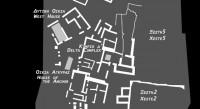
Building Complex Δ (Delta)
A plan of the middle section of the archaeological site showing the position of Building Complex Δ (Delta) in relation to other buildings. |
|
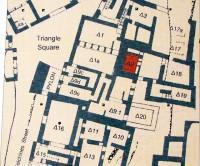
Plan of Complex Delta, showing its rooms |
|
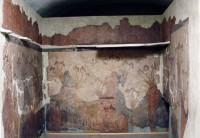
Santorini Akrotiri “Spring Fresco”
Building Complex Delta, Room Delta 2. South wall, H. 2.50 W. 2.22 m., West wall, H. 2.50 W. 2.60 m., North wall, H. 2.50 W. 1.88 m.
These three wall-paintings, named the «Spring Fresco», were located in room Delta 2, and extended along the southern, western, and northern walls. Painted with a variety of colors is a rocky landscape; within that landscape two motifs prevail: blossoming lilies and swallows.
Scholars have offered two separate identifications of the lilies represented. The first suggestion is that of sea-lilies (Pancratium Maritimum Ι.), which still grow on the beach and seaside of Santorini, blooming in late summer. While these lilies are white, the artist may have used red in order to create a contrast between the lily and the white background. Another more plausible interpretation is that the lily species depicted is the Lilium Chalcedonicum. Lilium Chalcedonicum has characteristic red petals with leaves that overlap like roofing tiles, oppressing the stem. This red lily is found in Greece, in the Aegean and the Ionian islands.
Two pairs of swallows are depicted, making seven in total. These swallows have been identified as Hirundo Rustica. This motif is unique to Theran art. Romantics have misinterpreted the pair of swallows’ motif as representative of kissing birds. Instead, ornithologists suggest that the two swallows engaging each other beak-on-beak are probably males, sparring for dominance. These highly stylized swallows have been gracefully rendered with long forked tails and swept back wings. The artist's skill in capturing the movement of these nimble birds is exceptional and could only have been derived from an extensive study of the subject matter. However, the artist's rendition of loops at the end of the swallows' tails is not accurate. |
|
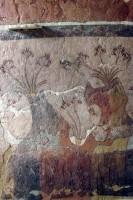
“Spring Fresco” South Wall Fresco |
|
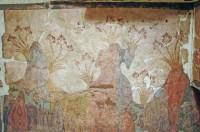
“Spring Fresco” West Wall Fresco |
|
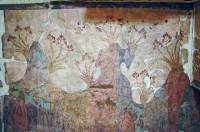
“Spring Fresco” North Wall Fresco |
|
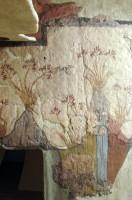
“Spring Fresco” North Wall Fresco (Detail) |
|
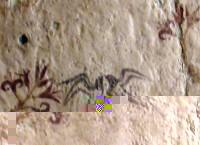
“Spring Fresco”, “Kissing Swallows” |
|
Select Page of the Album:
|
|



